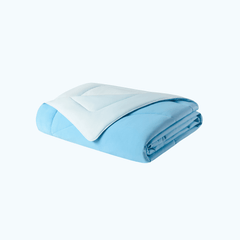How Thermal Environments Promote Better Sleep
Improve Your Sleep Quality by Fixing Your Sleep Environment
The space where you sleep, unsurprisingly, can influence the quality of your sleep and optimizing your bedroom ambiance may help for those restless at night. Factors such as light, noise, temperature and bedding should be carefully managed to create an ideal sleeping environment.

Why you Dim the Lights or Keep Lights Off for Bedtime
It’s important to limit exposure to artificial lights as it can interfere with your body's circadian rhythm. When preparing to sleep, turn off your lights, or at least dim the lights if you are in the midst of your bedtime routine. There has been a growing focus on how blue light and device use before bed can affect our ability to fall asleep, but this also extends to bedroom lights.
Street lights, passing cars and other light pollution can unintentionally signal to your body it’s time to wake up. Using a sleep mask or blackout curtains helps block these artificial lights and keep your room dark longer, especially for those who work during the night and want to avoid being woken up by sunlight. Blackout curtains that are a thicker material may potentially even block commercial noise from ruining your sleep.
Difficulty Sleeping Because of Noise?
Though a bit harder to control, noise or lack thereof can also affect quality of sleep. Earplugs can help silence sounds or if jarring, disruptive sounds are the issue, a white noise machine or fan can help you get accustomed to background noise to avoid being woken up. If your home is situated on a busy street and you have the budget, installing thicker double-paned windows can prevent city noise in your bedroom.

Effect of Temperature on Sleep
As something that you can’t see or hear, but can feel the difference, temperature has a profound effect on sleep quality. From room temperature, core body temperature to thermal environment, the right temperature across all these factors can lead to substantially better sleep quality.
What is the Ideal Temperature to Sleep in my Bedroom?
The ideal bedroom temperature for most people to sleep well is between 60-67 degrees Fahrenheit (around 15-20 degrees Celsius). This range helps facilitate the natural decrease in body temperature associated with sleep onset.
How Body Temperature Affects Sleep
Typically, the human body maintains a temperature around 98.6 degrees Fahrenheit (37 degrees Celsius) and experiences variations as the day progresses into night. This drop in core body temperature is controlled by a special part of the brain called the hypothalamic suprachiasmatic nucleus, which works like a clock to manage our daily cycles of feeling awake or sleepy and our body temperature. This decrease occurs approximately two hours before sleep, coinciding with the body's release of melatonin, a hormone essential for sleep regulation.
What Happens to Body Temperature When We Sleep?
As we start to fall asleep, our hands and feet get warmer because our body is sending more blood to our skin to lose heat and help us cool down. During sleep, our bodies become less active, we move less, and our muscles relax. This relaxation, along with changes in how our body controls temperature and blood flow, makes our core body temperature drop. As you sleep, the body's temperature keeps dropping, hitting its lowest level in the early hours of the morning before slowly rising just as you begin to wake up.
Lowering your room's temperature at night can enhance your body's natural sleep cycle by signalling it's time to rest. Research shows that aligning environmental temperatures with your body's core temperature is beneficial for sleep patterns and the body's natural sleep cycle.
What is Thermal Environment?
There is a reason why we’re always reaching for the cold side of the pillow during sleep and this is largely due to our body’s relationship with thermal environments. Thermal environments are the sensory experiences that affect heat transfer and in the context of sleep, are what we surround ourselves with when it’s bedtime. Thermal environments can be attributed to the unseen, like temperature and humidity of the bedroom, or objects, like clothing and bedding that you come into contact with.
How Thermal Environment Affects Sleep
A study found that “thermal environments are one of the most important factors that can affect human sleep.” Excessive heat can disrupt the natural thermoregulation process our bodies undergo during sleep stages, leading to restlessness and awakenings. Our thermal environment, particularly the ambient temperature of our sleeping spaces, such as beddings, can significantly affect sleep quality.
The body's core temperature naturally decreases as part of the sleep initiation process, and maintaining an environment that supports this natural drop is crucial. This is all to say that when our beds get too hot, we have difficulty falling and staying asleep, often then tossing and turning to find a cool spot or sticking our feet out from under the covers.
Does Bedding Affect or Improve Sleep?
Research suggests that, “where bedding and clothing are used, heat exposure increases wakefulness and decreases slow wave sleep and rapid eye movement (REM) sleep.” This stresses the importance of how certain bedding and sleepwear can negatively impact temperature regulation during sleep. Choosing breathable fabrics and bedding that can help maintain a comfortable sleeping temperature can directly impact sleep quality.
Through countless iterations, we developed Evercool®, an innovative fabric material that boasts one of the highest lab-tested Q-max value available. Q-max measures how effectively a fabric can regulate your body temperature. With a higher Q-max value, it also indicates better thermal conductivity, leading to a cooler, more optimal thermal environment and sleep space for longer.

Tips for Managing Thermal Environment
- Use breathable, moisture wicking bedding that allows for better air circulation. Consider: Evercool® Cooling Comforter to prevent night sweats from interrupting your sleep.
- Regulate room temperature by keeping your bedroom around 60-67 degrees Fahrenheit (around 15-20 degrees Celsius). Consider using a fan, air conditioner or the Evercool® line of products during warmer months and a natural down duvet in cooler months.
- Take a warm shower or bath before bedtime, which will help facilitate a drop in your body temperature, the natural prerequisite for feeling sleepiness.
By focusing on optimizing your sleep environment for minimal light and noise, and managing the temperature for optimal thermal comfort, you can foster conditions that promote restful and restorative sleep.






